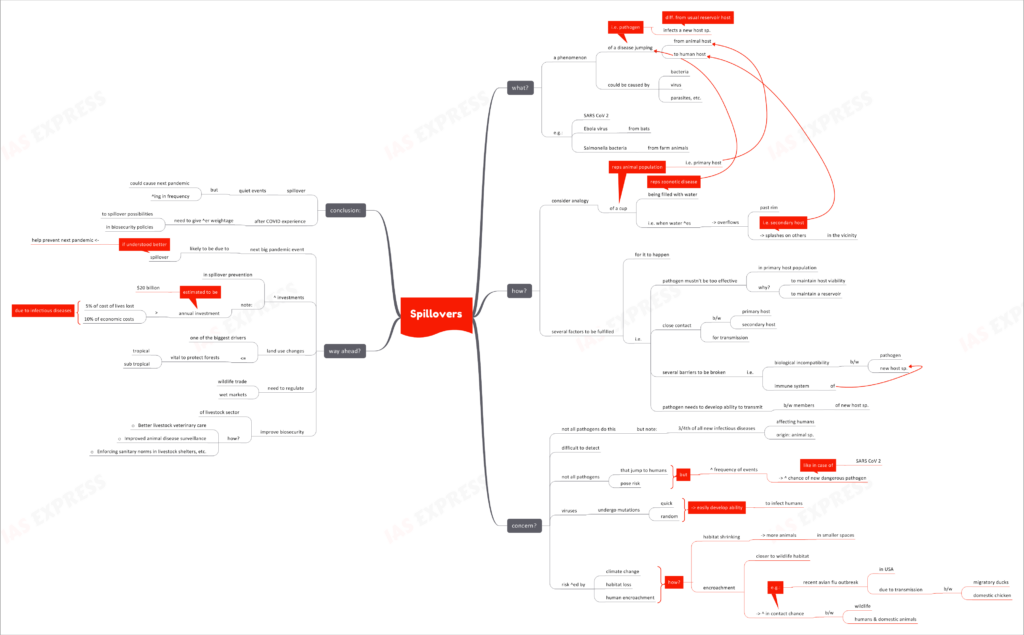Spillovers- Why Pay Attention?

From Current Affairs Notes for UPSC » Editorials & In-depths » This topic
IAS EXPRESS Vs UPSC Prelims 2024: 85+ questions reflected
As of February 2023, the ongoing avian influenza epidemic has killed over 58 million birds in the US alone. This follows on the heels of the unprecedented COVID-19 pandemic, highlighting the urgent need to pay attention to the issue of spillovers.

What is spillover?
- Spillover refers to a phenomenon in which a disease jumps from animals to human hosts i.e. the pathogen infects a novel host- a species different from its usual reservoir host.
- A variety of disease causing pathogens can cause spillovers- bacteria, virus, parasites, etc.
- The SARS CoV 2, the pathogen behind the COVID-19 pandemic, is a notable example of this phenomenon. Other examples include Ebola virus from bats and the Salmonella bacteria from farm animals.
How does it happen?
- To understand how pathogen spillover happens, it is useful to consider the analogy of water being filled into a cup. Here, the cup is the host animal population and the water, the zoonotic disease.
- When the water level increases in the cup, to flow over the rim, it leads to a spillover. This leads to those in the vicinity (i.e. human populations) to get splashed.
- For a pathogen to be capable of causing such spillover event, several factors need to be fulfilled.
- The pathogen mustn’t be too effective in its primary host population. This is so that host species viability isn’t destroyed and it continues to act as a reservoir for the pathogen.
- There needs to be close contact between the primary host species and the novel host species for the transmission to take place.
- Then the pathogen has several more barriers to break through- such as biological incompatibility between the pathogen and the new host and the latter’s immune response.
- The pathogen also needs to develop the ability to transmit between members of the new host species.
Why is it concerning?
- Though not all pathogens are capable of causing such spillover events, it is noteworthy that 3/4th of all new infectious diseases among humans originated from animals.
- These events are difficult to detect.
- While not all pathogens that jump to human hosts pose a risk, the more frequently this happens, greater the chances are for the advent of a dangerous new pathogen to take root- as in case of the SARS CoV 2.
- Viral spillovers are especially concerning as they undergo very quick and random genetic mutations, making them capable of acquiring the spillover ability more easily.
- The ongoing climate change, habitat destruction and anthropogenic encroachment into natural habitats is increasing the risk of such events.
- This is because shrinking habitats mean increasing number of animals are being crowded into smaller areas- favouring disease transmission.
- As human settlements expand closer to wildlife habitats, the chances of reservoir host animals coming into contact with people and farm animals increases. For instance, the recent avian flu outbreak in the USA is because of spillover from migrating duck to domestic chicken.
What is the way ahead?
- There is a high chance of the next big pandemic risk being triggered by a spillover event. The more this phenomenon is understood, better will be the chance of preventing it.
- There is a need to increase investment in spillover prevention. Note that the annual cost of such initiative (estimated at $20 billion) is less than 5% of what it costs in lives lost due to emerging infectious diseases and less than 10% of such diseases’ economic costs.
- As land use changes is one of the biggest drivers of such events, it is vital to protect forests in the tropical and sub-tropical regions.
- A key lesson from the COVID-19 pandemic is the importance of regulating wildlife trade and wet markets.
- Steps to improve biosecurity of livestock sector is also vital.
- Better livestock veterinary care
- Improved animal disease surveillance
- Enforcing sanitary norms in livestock shelters, etc.
Conclusion:
Spillovers are quiet events that could blow up into the next COVID-19 pandemic and these are happening with increasing frequency. After our experiences from the pandemic, it is wise for governments to give greater weightage to spillover possibilities in their biosecurity policies.
Practice Question for Mains:
What is spillover? How does it happen and what are the concerns going ahead? (250 words)
If you like this post, please share your feedback in the comments section below so that we will upload more posts like this.

